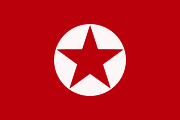Workers' Party of South Korea 남조선로동당 | |
|---|---|
| Chairman | Ho Hon |
| Vice Chairman | Pak Hon-yong Yi Ki-sok |
| Founded | 23 November 1946 |
| Dissolved | 24 June 1949 |
| Merger of | CPK NPPK |
| Merged into | WPK |
| Newspaper |
|
| Membership | 360,000 (1947 estimate) |
| Ideology | |
| Political position | Far-left |
| Party flag | |
 | |
The Workers' Party of South Korea (Korean: 남조선로동당) was a communist party in South Korea from 1946 to 1949. It is also sometimes colloquially referred to as the "Namro Party" (남로당; 南勞黨). It was founded on 23 November 1946 through the merger of the Communist Party of South Korea, New People's Party of Korea and a faction of the People's Party of Korea (the so-called 'forty-eighters').[1] It was led by Ho Hon.[2][failed verification]
The party was outlawed by the U.S. occupation authorities due to the party being an aggravating opposition to South Korea and the US, but the party organized a network of clandestine cells and was able to obtain a considerable following. It had around 360,000 party members.[3] In 1947, the party initiated armed guerrilla struggle. As the persecution of party intensified, large sections of the party leadership moved to Pyongyang.
The party was opposed to the formation of a South Korean state. In February–March 1948, it instigated general strikes in opposition to the plans to create a separate South Korean state.[4] On 3 April 1948, the party led a popular uprising on Jeju island, against the unilateral declaration of the foundation of the Republic of Korea. In the suppression of the revolt, thousands of islanders were killed (see Jeju massacre), largely by forces of the South Korean Government.[citation needed]
In one of its first official acts, the South Korean National Assembly passed the National Security Act in September 1948, which among other measures, outlawed the Workers' Party of South Korea.[5]
On 24 June 1949, the party merged with the Workers' Party of North Korea, forming the Workers' Party of Korea.[6] The WPNK leader Kim Il Sung became party chairman, whereas Pak Hon-yong became deputy chairman.
In the Korean War, 60,000 to 200,000 members of the party and suspected communist supporters, many of them civilians, were massacred by the South Korean Army with supervision of the US army[7] in what became known as the Bodo League massacre.
The clandestine trade union movement, the All Korea Labor Union (Chŏnp'yŏng) was connected to the party.
References
- ^ Suh, Dae-Sook (1986). "North Korea in 1985: A New Era after Forty Years". Asian Survey. 26 (1): 78–85. doi:10.2307/2644095. JSTOR 2644095.
- ^ Online, Asia Time. "Asia Times Online :: Korea News - Part 5: Kim Il-sung and China". Archived from the original on 19 October 2006. Retrieved 4 September 2016.
{{cite web}}: CS1 maint: unfit URL (link) - ^ Lee, Chong-Sik (1963). "Politics in North Korea: Pre-Korean War Stage". The China Quarterly. 14 (14): 3–16. doi:10.1017/S0305741000020981. JSTOR 651339. S2CID 154806824.
- ^ "Eisenhower Lecture #7: Allan R. Millett". Archived from the original on 7 September 2006. Retrieved 12 April 2007.
- ^ Carter Malkasian (25 September 2001). The Korean War (Essential Histories) (25 September 2001 ed.). Osprey Publishing. p. 2222. ISBN 1-84176-282-2.
- ^ KBS WORLD Radio
- ^ "New evidence of Korean war killings". BBC News. 21 April 2000. Retrieved 4 June 2022.
